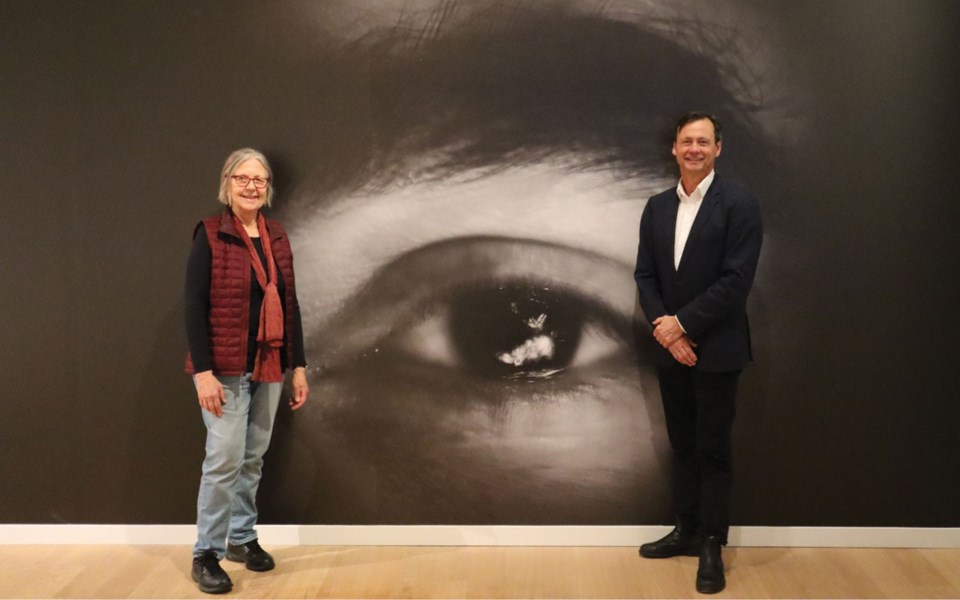To make Direct Photograph of an Electric Positive Spark in 1888, early photographer Étienne Léopold Trouvelot created an electrical charge with a wand, transferred it to a photographic plate and created an exposure.
The effect: a burst of electricity frozen in time—as if someone captured the pitch-black prairie night sky during a summer thunderstorm.
"His interest was in trying to distinguish between types of lightning forms," says Ann Thomas, interim chief curator at the National Gallery of Canada (NGA).
Thomas, who curated The Extended Moment: Fifty Years of Collecting Photographs, is standing in front of the image, freshly hung at the Audain Art Museum.
Next to it is a similar photograph—called Lightning Fields, created in 2009, clearly inspired by its predecessor—by the contemporary film photographer Hiroshi Sugimoto.
"He is doing the same thing, but technologically, we have advanced hugely," Thomas says. "He uses the wand on his film plates, so the same kind of thing, but he's looking for what kind of electrical forms existed in the beginning of the creation of the universe—an impossible task. Then he also places—I think [it] sounds highly dangerous—where he'll take the charge and put it in an aqueous solution and puts it on places where he'll get different forms of these bursts of light."
The complementary images are just two of 81 in the show, which is on display outside of Ottawa for only the second time. While it celebrates 50 years of the NGA collecting photographs, the actual images featured span over 100 years, from the late 19th century to present day.
"Our collection is very comprehensive, starting with not just the earliest examples of photography, but also the pre-history of photography," Thomas says. "So the very basic optical mechanisms for the camera obscura for example ... The idea was, 'How can we look at the collection [and] celebrate its 50 years of existence?' Because it was quite remarkably progressive on the part of Jean Boggs, who was the director in 1967, who was a friend of Man Ray and also had been doing her research on Degas and realized that these images had an intellectual meaning in the history of art and recovered them."
Electrical experiments aside, the show ranges from showcasing the dark room experimentation of Alison Rossiter to important historical images like Florence Owens Thompson's Migrant Mother to modern-day Canadian photographers like Edward Burtynsky, Stan Douglas, and Lynne Cohen.
"One of the reasons that this show is very attractive to us was because a major component of our permanent collection is photography," says Curtis Collins, director and chief curator of the museum, referring to the photoconceptualist work of Jeff Wall and Rodney Graham.
To that end, Collins also knew an exhibit delving into the medium would appeal to Whistler, which is packed with action sports photographers. In April, local photographer Chad Chomlack will lead a panel discussion in which he reflects on the exhibit. The museum will also be an official exhibit location for Vancouver's Capture Photography Festival.
"Photography is popular in Whistler," Collins says. "I went to the [Pro Photographer Showdown] photo challenge—part of the reason for choosing this show was also the fact that there are so many active photographers here. They do a lot of ski and mountain biking photos, but we're hoping that this will lead them into some new processes and ideas to expand their own practices."
But taken as a whole—and considering those action-packed images sports photographers manage to capture today—the exhibit depicts just how much cameras and photography has changed in a relatively short time.
Laura Minta Holland, the education and volunteer manager at the museum, also approached local photographers to borrow a range of cameras from their collections to highlight that concept.
"This is a really important area of engagement for us because it gets you a little closer to the show," Collins says.
"These are all the kind of touchstones of this exhibition that are a good fit for Whistler and establishes [the museum] nationally." The Extended Moment: Fifty Years of Collecting Photographs opens at the Audain Art Museum on Saturday, Feb. 8 and runs until May 25.




